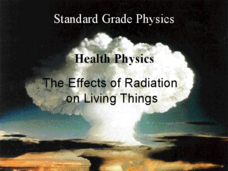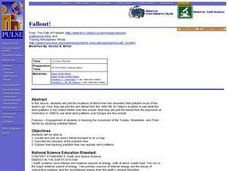Curated OER
World War II
Young scholars analyze primary sources (photographs) for evidence of American military technology during WWII. They debate the use of the Atomic Bomb. Students view the Rosenthal image. They discuss the image in detail.
Curated OER
Victory in the Pacific
Learners explore the overall Allied strategy in the Pacific from 1943-1945 and assess its effectiveness. They explore the reasons why the atomic bomb was used and why use of that weapon was controversial.
Curated OER
Attack on Hiroshima and Nagasaki
Sixth graders hear a story about the atomic bombing of Japan and write an editorial about the event from the perspective of either a Japanese or an American.
Curated OER
Peace
Ninth graders explore through research changes in Japan following A-bomb, discuss how people of all ages can model tolerance and peaceful coexistence, examine Constitution of Japan, and identify its three basic tenants.
Curated OER
Radioactive: An Interdisciplinary Study of Marie and Pierre Curie
Use this innovative text to show the far-reaching influence of the dynamic Curie couple
Education World
Every Day Edit - Hiroshima Bombing
In this everyday editing instructional activity, students correct grammatical mistakes in a short paragraph about the Hiroshima bombing. The errors range from punctuation, spelling, grammar, and capitalization.
Curated OER
Sadako and the Thousand Paper Cranes
Have your class explore the effects of war by reading Eleanor Coerr's story, "Sadako and the Thousand Paper Cranes." This is a story about a sixth grader who lives in Hiroshima when the atomic bomb is dropped. Learners answer questions,...
PhET
Radioactive Dating Game
Uranium 235 has a half-life of over 700 million years and is the fuel used in the atomic bomb dropped on Hiroshima, Japan. Pupils see the half-lives and decay rates of Carbon-14 and Uranium-238. They also take measurements of these two...
Curated OER
Victory in the Pacific, 1943-1945
High schoolers examine the military campaigns of the Pacific theater, tracing the path of the Allied offensives. The lesson presents what the Allies were trying to accomplish and why.
Curated OER
Health Physics: The Effects of Radiation on Living Things
A mix of scientific details and background information about the well-known sites of radiation attacks or accidents. This topic may open up details that you may consider as sensitive, and could be upsetting to some pupils. This is a...
Curated OER
Learning Empathy Through Art
Students observe the painting, From That Day On, by Ben Shahn, and reflect on the story of the Lucky Dragon. They research and discuss the physical and emotional side effects on the Japanese people after the atomic bomb was dropped.
BAE Systems
The Cold War
The Soviet Union's decision to block West Berlin from access by the Western allies began an international hostility that extended into the rest of the twentieth century. Class members examine both Harry Truman's and Joseph Stalin's...
Curated OER
Breaking News English: 60th Anniversary of Hiroshima Bombing
In this English instructional activity, students read " 60th Anniversary of Hiroshima Bombing," and then respond to 47 fill in the blank, 7 short answer, 20 matching, and 8 true or false questions about the selection.
Curated OER
United States - Japanese Relations In Post World War II Era
Ninth graders explore the relationship between the United States and Japan. In groups, classmates research the treatment of Koreans and Americans as prisoners of war. Pupils examine the effect of politics and agreements during the war....
Curated OER
Fallout
Students view a short film about the results of dropping the atomic bomb at the end of World War II. They research controversies surrounding the use of the bomb and nuclear weapons. They write two editorials about the issue.
Curated OER
Connection to Social Studies: Linus Pauling: A Life Well Spent
In this atomic energy worksheet, learners read about Linus Pauling, who spent years making the public aware of the dangers of nuclear weapons. They answer questions about his work and the social responsibility he took on which led to the...
Curated OER
Sadako: A Tribute to a Girl with Cancer
Students explore the story of Sadako, a young girl, who had leukemia as a result of a bomb being dropped on Hiroshima in 1955. They create a chain of paper cranes and design a fund-raising event. They write poems in the Japanese style of...
Curated OER
Dancing in the Desert: The Genie
Fifth graders study nuclear destruction using visual literacy. In this nuclear destruction lesson, 5th graders work in groups to examine a group of pictures that show the destruction of a home by a nuclear blast. They discuss the type of...
Annenberg Foundation
Postwar Tension and Triumph
Go get the American Dream lifestyle! The 19th lesson in a 22-part series exploring American history shows learners the post-WWII economic boom. Using primary sources, photographs, and cartoons, groups discuss their findings and present...
Curated OER
Structured Academic Controversy (SAC) in the History Classroom
SAC is a specific approach to discussing history and controversial issues. Rather than adhering to an either/or debate-style paradigm, it fosters speaking and constructivist listening to enable learners to build consensus through...
Smithsonian Institution
Cuban Missile Crisis
The United States—specifically John F. Kennedy—played a large role during the Cuban Missile Crisis. A history resource poses questions that encourage critical thinking as well as in-depth analysis of images from the time period.
Curated OER
It's Up for Debate
Students work together to research issues surrounding World War II. They review the decisions that were made at the time. They participate in a debate and how those decisions maintained world peace.
Curated OER
An English-Speaking World
An overview of the development of English as a global language fills out these slides. Beginning with statistics regarding how much of the world speaks English and to what capacity, a brief history is then given mostly pertaining to WWII...
Curated OER
GRAVE OF THE FIREFLIES
Students engage in a video activity to research the effects of war upon the Japanese to live in the world after World War II. They answer specific questions in order to complete the unit.

























